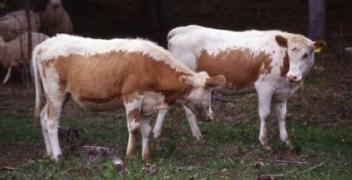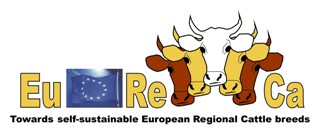Eastern Finncattle
 Photo: Tapio Tuomela/Copyright: MTT |
|
History
The Eastern Finncattle cows were recognized as a separate breed in the 1890's. There was a need to improve milk production. The recognition of breeds was part of the development work. The general interest in well-characterized breeds coincided with strong nationalistic feelings at the time. The eastern part of the country – especially Karelia and Savo - was less affected by imported cattle breeds compared to the areas in the western and southern part of the country. The keepers of the Eastern Finncattle founded a breed society in 1898 at the cattle show in Kuopio (Savo). This was the first cattle breeding organisation in Finland. The Northern Finncattle society was started in 1905 and that for the Western Finncattle in 1906.The herdbook for the Eastern Finncattle began in 1914 and by 1927 there were 4620 bulls and 14650 cows registered by 4233 society members. First attention in selection was given to breed characteristics. The cows in remote villages were considered as the most pure bred ones and breed description used words like handsome and gentle. From the 1920's onwards the emphasis on exterior traits made way to selection on recorded production.
The wartime hit dramatically the Eastern and Northern Finncattle. People from the lost eastern part moved with their Eastern Finncattle cows to different parts of the country. Along the declining cow numbers the three Finncattle societies resorted to collaboration and were amalgamated in 1946. At that time there were some 5000 Eastern Finncattle in the herd book.
The Ayrshire cattle spread to eastern and northern parts of the country in the 1950's. Another blow to local breeds was to use Finncattle cows in crossing with imported Friesian semen in the 1960's. Consequently the less productive indigenous cows were abandoned as out-dated and unfashionable. The Eastern Finncattle sank to the bottom lowest numbers in the 1980's having only some 50 cows and less than 10 bulls left.
Prof Kalle Maijala at MTT Agrifood Research Finland paid as early as in the late 1960's attention to the erosion of the breed spectrum. He was one of the initiators for the EAAP working group on animal genetic resources started in 1980, for the Nordic Gene Bank which started as a working group in 1980 and as an independent entity supported by Nordic Council of Ministers in 1991, and for the respective national committee in Finland which has been functioning in different forms since 1983.
A very unique feature of the Finnish programme is the collaboration with the prison farms, which at one time housed cows of all the three Finncattle breeds. There is now a society for Indigenous breeds and the breeding organisation Faba Breeding is carrying out registration and advisory work also for the rare Finncattle breeds. Since joining the EU, Finland has been actively supporting farmers raising rate local breeds. Persons from different parts of the society have taken part in rescuing herds threatened to die out. Also the media is eager to report news on Finnish rare breeds and the general public knows all the indigenous breeds.
The widely available molecular genetic techniques have been used to give a general picture on the relationships between the cattle breeds and the state of the genetic variation within the breeds. The Eastern Finncattle breed has a high conservation value with a considerable deviation from the pool of cattle breeds and with a substantial amount of within breed variability.
The systematic work by enthusiastic and stubborn persons has proved fruitful. The cow register recognizes now the indigenous breeds. In 1997 the number of purebred cows exceeded a hundred both in the Eastern and Northern Finncattle. At the moment in the Eastern Finncattle the number of purebred (down to four generations) cows is around 450. The number is slowly growing. The AI cooperatives have several bulls stored. In choosing the breeding cows and bulls, a special attention is given to the development of coancestries in the population. As an ex situ scheme, embryos and semen doses are annually deposited in the cryo-bank.
The breed is currently enjoying healthy popularity. There are few restaurants in major cities offering products made of milk and meat of Eastern Finncattle. They are also used in landscape management and even in modern therapy practices.


